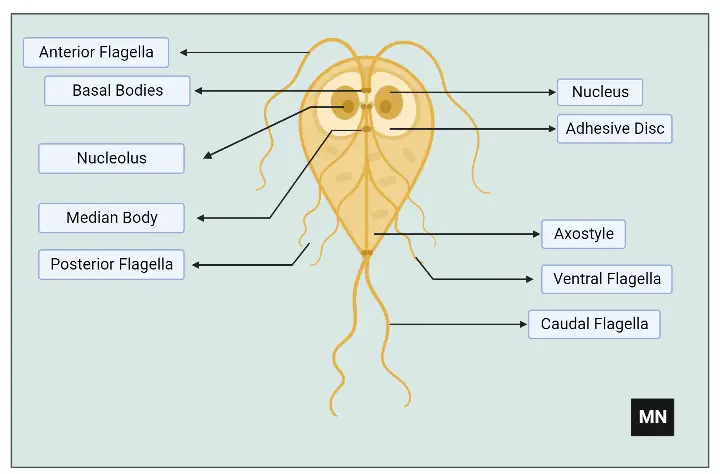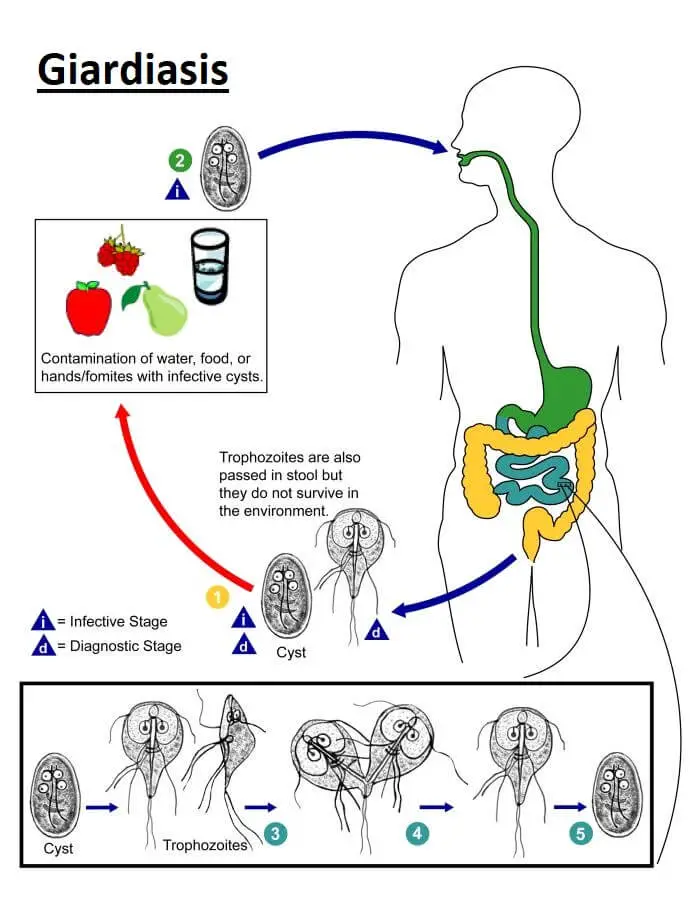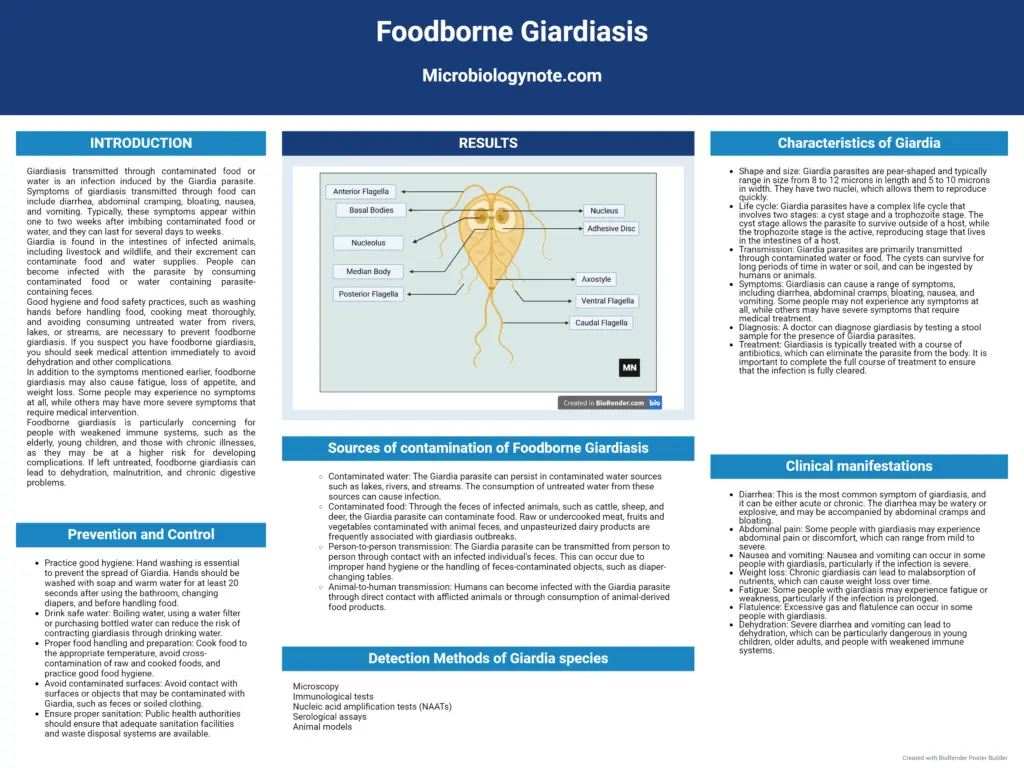Table of Contents
What is Foodborne Giardiasis?
- Giardiasis transmitted through contaminated food or water is an infection induced by the Giardia parasite. Symptoms of giardiasis transmitted through food can include diarrhea, abdominal cramping, bloating, nausea, and vomiting. Typically, these symptoms appear within one to two weeks after imbibing contaminated food or water, and they can last for several days to weeks.
- Giardia is found in the intestines of infected animals, including livestock and wildlife, and their excrement can contaminate food and water supplies. People can become infected with the parasite by consuming contaminated food or water containing parasite-containing feces.
- Good hygiene and food safety practices, such as washing hands before handling food, cooking meat thoroughly, and avoiding consuming untreated water from rivers, lakes, or streams, are necessary to prevent foodborne giardiasis. If you suspect you have foodborne giardiasis, you should seek medical attention immediately to avoid dehydration and other complications.
- In addition to the symptoms mentioned earlier, foodborne giardiasis may also cause fatigue, loss of appetite, and weight loss. Some people may experience no symptoms at all, while others may have more severe symptoms that require medical intervention.
- Foodborne giardiasis is particularly concerning for people with weakened immune systems, such as the elderly, young children, and those with chronic illnesses, as they may be at a higher risk for developing complications. If left untreated, foodborne giardiasis can lead to dehydration, malnutrition, and chronic digestive problems.
- To diagnose foodborne giardiasis, a doctor may order a stool sample test or perform an endoscopy to view the intestines and identify the presence of the Giardia parasite. Treatment for foodborne giardiasis typically involves a course of antibiotics prescribed by a medical professional.
- It is important to take precautions when preparing and consuming food, particularly when traveling to areas with poor sanitation or limited access to clean water. By practicing good hygiene and food safety habits, individuals can reduce their risk of contracting foodborne giardiasis and other foodborne illnesses.
Characteristics of Giardia
Giardia is a genus of microscopic, single-celled parasites that can cause the infection known as giardiasis. Here are some characteristics of Giardia:

- Shape and size: Giardia parasites are pear-shaped and typically range in size from 8 to 12 microns in length and 5 to 10 microns in width. They have two nuclei, which allows them to reproduce quickly.
- Life cycle: Giardia parasites have a complex life cycle that involves two stages: a cyst stage and a trophozoite stage. The cyst stage allows the parasite to survive outside of a host, while the trophozoite stage is the active, reproducing stage that lives in the intestines of a host.
- Transmission: Giardia parasites are primarily transmitted through contaminated water or food. The cysts can survive for long periods of time in water or soil, and can be ingested by humans or animals.
- Symptoms: Giardiasis can cause a range of symptoms, including diarrhea, abdominal cramps, bloating, nausea, and vomiting. Some people may not experience any symptoms at all, while others may have severe symptoms that require medical treatment.
- Diagnosis: A doctor can diagnose giardiasis by testing a stool sample for the presence of Giardia parasites.
- Treatment: Giardiasis is typically treated with a course of antibiotics, which can eliminate the parasite from the body. It is important to complete the full course of treatment to ensure that the infection is fully cleared.
Overall, Giardia is a highly adaptable and resilient parasite that can cause a range of symptoms in humans and animals. By practicing good hygiene and food safety habits, individuals can reduce their risk of contracting giardiasis and other parasitic infections.
Sources of contamination of Foodborne Giardiasis
The parasite Giardia can induce foodborne giardiasis when contaminated food or water is consumed. The following are common contamination sources:
- Contaminated water: The Giardia parasite can persist in contaminated water sources such as lakes, rivers, and streams. The consumption of untreated water from these sources can cause infection.
- Contaminated food: Through the feces of infected animals, such as cattle, sheep, and deer, the Giardia parasite can contaminate food. Raw or undercooked meat, fruits and vegetables contaminated with animal feces, and unpasteurized dairy products are frequently associated with giardiasis outbreaks.
- Person-to-person transmission: The Giardia parasite can be transmitted from person to person through contact with an infected individual’s feces. This can occur due to improper hand hygiene or the handling of feces-contaminated objects, such as diaper-changing tables.
- Animal-to-human transmission: Humans can become infected with the Giardia parasite through direct contact with afflicted animals or through consumption of animal-derived food products.
To prevent foodborne giardiasis, it is essential to practice excellent hygiene and food safety, such as washing hands before handling food, cooking meat thoroughly, and avoiding drinking untreated water that may be contaminated. Moreover, if you suspect that you have been infected with the Giardia parasite, you should seek medical attention immediately.
Clinical manifestations of Foodborne Giardiasis
Foodborne giardiasis is an infection caused by the ingestion of food or water contaminated with the Giardia parasite. The clinical manifestations of giardiasis can vary widely, and some people may not experience any symptoms at all. However, common symptoms of foodborne giardiasis can include:
- Diarrhea: This is the most common symptom of giardiasis, and it can be either acute or chronic. The diarrhea may be watery or explosive, and may be accompanied by abdominal cramps and bloating.
- Abdominal pain: Some people with giardiasis may experience abdominal pain or discomfort, which can range from mild to severe.
- Nausea and vomiting: Nausea and vomiting can occur in some people with giardiasis, particularly if the infection is severe.
- Weight loss: Chronic giardiasis can lead to malabsorption of nutrients, which can cause weight loss over time.
- Fatigue: Some people with giardiasis may experience fatigue or weakness, particularly if the infection is prolonged.
- Flatulence: Excessive gas and flatulence can occur in some people with giardiasis.
- Dehydration: Severe diarrhea and vomiting can lead to dehydration, which can be particularly dangerous in young children, older adults, and people with weakened immune systems.
The symptoms of giardiasis can appear anywhere from 1 to 3 weeks after exposure to the parasite, and can last for several weeks or even months in some cases. If you suspect that you have been infected with Giardia, it is important to seek medical attention promptly to receive appropriate treatment and prevent complications.
Epidemiology of Foodborne Giardiasis
Foodborne giardiasis is a common parasitic infection that affects people all over the world. Here are some epidemiological factors associated with foodborne giardiasis:
- Global prevalence: Giardiasis is a widespread infection, with an estimated 200 million cases occurring worldwide each year.
- Age and gender: Giardiasis can affect people of all ages and genders, but it is more common in children and young adults.
- Seasonal variations: In many countries, giardiasis is more common during the summer months, when there is a higher incidence of water and food contamination.
- Risk factors: People who are at higher risk of developing giardiasis include those who travel to areas with poor sanitation, people who drink untreated water from lakes or rivers, people who work with animals, and people who live in institutions such as nursing homes or childcare facilities.
- Contaminated water and food: The primary mode of transmission for giardiasis is through the consumption of contaminated water or food. Cysts shed by infected individuals can contaminate water sources, food, and surfaces, leading to widespread transmission.
- Outbreaks: Outbreaks of giardiasis can occur when a large group of people consume contaminated food or water. These outbreaks have been reported in many different settings, including schools, camps, restaurants, and nursing homes.
- Prevention: Preventing foodborne giardiasis requires measures such as proper hand washing, proper food handling and preparation, and the treatment of water sources to prevent contamination.
Overall, foodborne giardiasis is a significant public health concern, with a high global burden of disease. By taking steps to prevent contamination of food and water sources, individuals and communities can reduce their risk of contracting giardiasis and other parasitic infections.
Detection Methods of Giardia species
Giardia species can be detected using a variety of methods, including:
- Microscopy: The most common method for detecting Giardia is through microscopy, which involves examining stool samples for the presence of cysts or trophozoites. This method is relatively inexpensive and straightforward, but it may miss infections with low parasite loads.
- Immunological tests: Immunological tests, such as enzyme-linked immunosorbent assays (ELISAs), can be used to detect Giardia antigens or antibodies in blood or stool samples. These tests are highly specific and sensitive, but they can be costly and require specialized equipment.
- Nucleic acid amplification tests (NAATs): NAATs, such as polymerase chain reaction (PCR) or loop-mediated isothermal amplification (LAMP), can detect Giardia DNA in stool samples with high sensitivity and specificity. These tests are rapid and require minimal sample preparation, making them useful for screening large numbers of samples.
- Serological assays: Serological assays can detect antibodies against Giardia in blood samples. These tests are not useful for diagnosing acute infections, but they can be useful for identifying previous exposure to the parasite.
- Animal models: Giardia can also be detected using animal models, such as gerbils or mice. These models can be used to study the pathogenesis of Giardia infections and to evaluate new treatments or vaccines.
Prevention and Control measures of Foodborne Giardiasis
Prevention and control measures of foodborne giardiasis include:
- Practice good hygiene: Hand washing is essential to prevent the spread of Giardia. Hands should be washed with soap and warm water for at least 20 seconds after using the bathroom, changing diapers, and before handling food.
- Drink safe water: Boiling water, using a water filter or purchasing bottled water can reduce the risk of contracting giardiasis through drinking water.
- Proper food handling and preparation: Cook food to the appropriate temperature, avoid cross-contamination of raw and cooked foods, and practice good food hygiene.
- Avoid contaminated surfaces: Avoid contact with surfaces or objects that may be contaminated with Giardia, such as feces or soiled clothing.
- Ensure proper sanitation: Public health authorities should ensure that adequate sanitation facilities and waste disposal systems are available.
- Education and awareness: Education on the transmission of giardiasis and preventative measures is essential to reduce the incidence of infection.
- Treatment of infected individuals: Infected individuals should receive prompt medical attention and treatment to avoid further transmission.
Pathogenesis of Giardia species

- In this infectious stage of their life cycle, Giardia cysts can contaminate food, water, and surfaces, and they can cause giardiasis when ingested.
- When a person ingests Giardia cysts from contaminated water, food, palms, surfaces, or objects, they become infected.
- When Giardia cysts are ingested, they travel through the pharynx, esophagus, and stomach to the small intestine, where each cyst releases two trophozoites via a process known as excystation.
- The trophozoites of Giardia then feed on and extract nutrients from the infected individual. Giardia trophozoites proliferate through a process known as longitudinal binary fission, in which they divide in half and remain in the small intestine, where they may be free or attached to the inner lining of the small intestine.
- The Giardia trophozoites then migrate toward the colon and undergo encystation, a transformation back into cyst form. The Giardia cyst is the most prevalent stage found in stool.
- Giardia cysts and trophozoites can be observed under the microscope to diagnose giardiasis when they are present in the faeces of a person with giardiasis. Giardia cysts are instantaneously infectious when passed in feces or shortly thereafter, and they can survive in cold water or soil for several months.

FAQ
What is foodborne giardiasis?
Foodborne giardiasis is an illness caused by the Giardia parasite, which can be contracted by consuming food or water contaminated with fecal matter containing the parasite.
How long does it take for symptoms to appear after being infected with Giardia?
Symptoms of foodborne giardiasis usually appear within 1-2 weeks after infection.
How is foodborne giardiasis diagnosed?
Foodborne giardiasis can be diagnosed by examining stool samples under a microscope, performing an ELISA test, or by using nucleic acid amplification tests (NAATs).
What are the symptoms of foodborne giardiasis?
The symptoms of foodborne giardiasis include diarrhea, abdominal cramps, nausea, vomiting, and weight loss.
How is foodborne giardiasis treated?
Foodborne giardiasis is usually treated with prescription medications, such as metronidazole or tinidazole.
Can foodborne giardiasis be prevented?
Yes, foodborne giardiasis can be prevented by practicing good hygiene, drinking safe water, proper food handling and preparation, avoiding contaminated surfaces, ensuring proper sanitation, education and awareness, and treatment of infected individuals.
Who is at risk for foodborne giardiasis?
Anyone can contract foodborne giardiasis, but those with weakened immune systems or who are traveling to areas with poor sanitation are at higher risk.
Can animals transmit giardiasis to humans?
Yes, animals, particularly domestic pets such as dogs and cats, can transmit giardiasis to humans.
Can giardiasis be fatal?
Giardiasis is typically not fatal, but it can lead to dehydration and malnutrition in severe cases, particularly in vulnerable populations such as children or the elderly.
Can giardiasis recur after treatment?
Yes, giardiasis can recur after treatment, particularly if there is ongoing exposure to contaminated food or water sources. It is important to practice prevention measures even after successful treatment.
References
- Beiromvand M, Mirrezaie E, Mirzavand S. Foodborne Giardiasis: Is There Any Relationship Between food Handlers and Transmission of Giardia duodenalis? Infect Disord Drug Targets. 2017;17(2):72-76. doi: 10.2174/1871526517666170111105040. PMID: 28079004.
- Ryan, U., Hijjawi, N., Feng, Y., & Xiao, L. (2018). Giardia: an under-reported foodborne parasite. International Journal for Parasitology. doi:10.1016/j.ijpara.2018.07.003
- Carranza, P. G., & Lujan, H. D. (2010). New insights regarding the biology of Giardia lamblia. Microbes and Infection, 12(1), 71–80. doi:10.1016/j.micinf.2009.09.008
- Dawson D. Foodborne protozoan parasites. Int J Food Microbiol. 2005 Aug 25;103(2):207-27. doi: 10.1016/j.ijfoodmicro.2004.12.032. PMID: 16083823.
- Anantaphruti MT. Parasitic contaminants in food. Southeast Asian J Trop Med Public Health. 2001;32 Suppl 2:218-28. PMID: 12041594.
- Pozio E. Foodborne and waterborne parasites. Acta Microbiol Pol. 2003;52 Suppl:83-96. PMID: 15058817.
